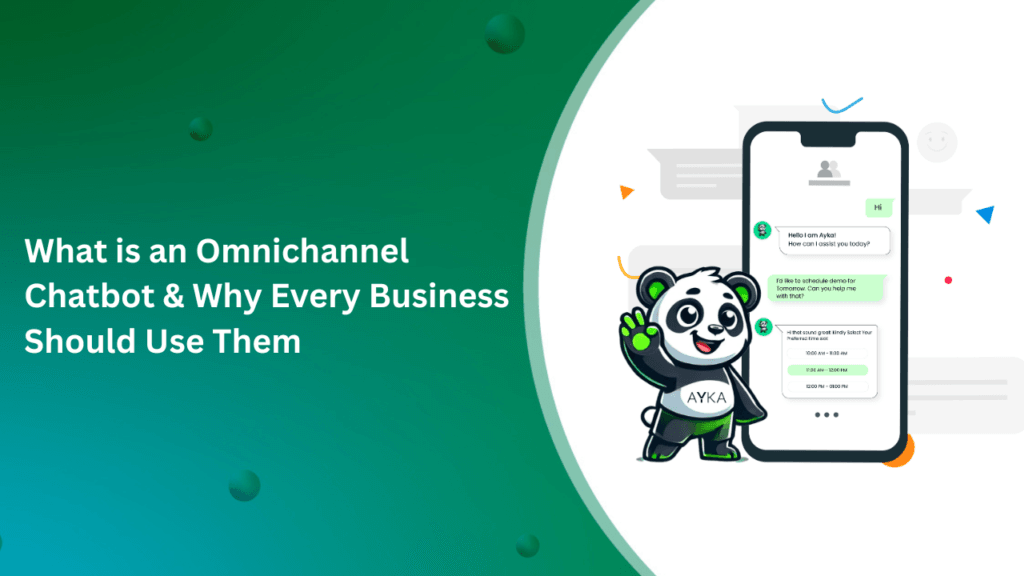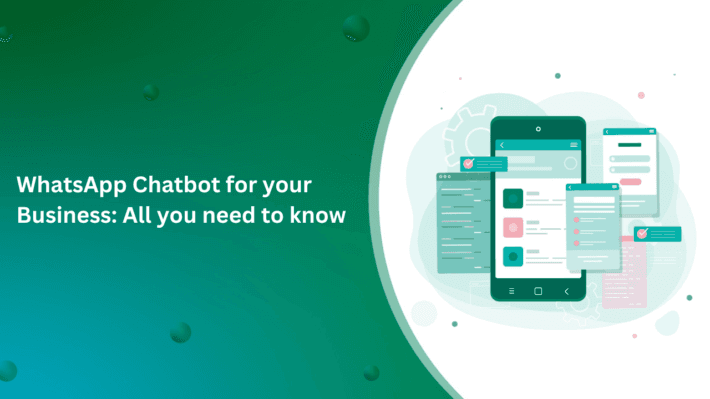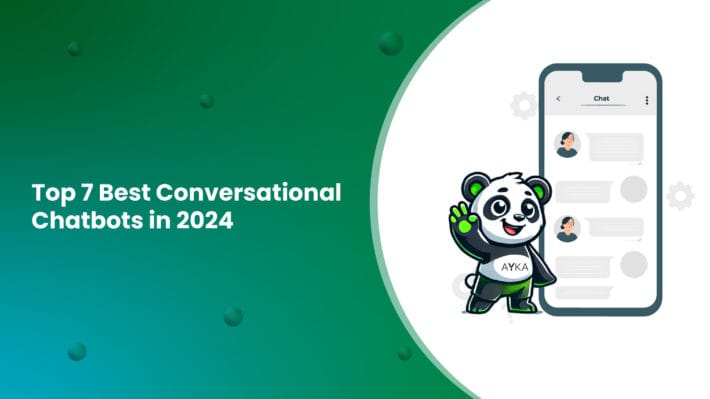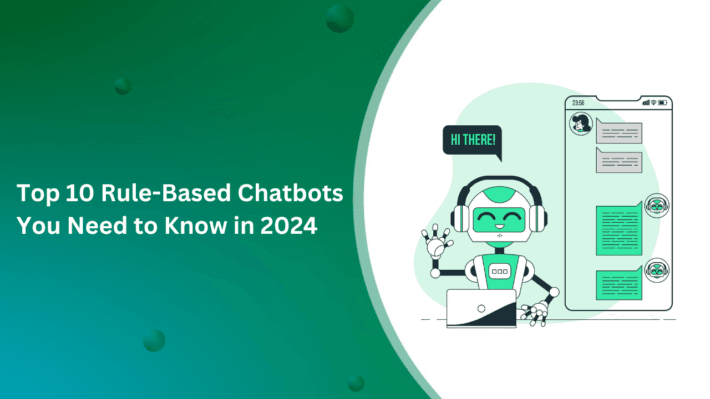Omnichannel Chatbots: How its Working, and Best Practices

In today’s digital world, customers want quick, smooth experiences across all the channels they use. Studies show that 90% of consumers expect consistent interactions no matter how they contact a business. Companies that deliver this seamless experience are able to retain 91% more customers.
Omnichannel chatbots make it easy for businesses to manage customer conversations across multiple platforms, keeping everything connected. Whether customers reach out through social media, email, or live chat, these chatbots ensure the experience is smooth and consistent.
In this blog, we’ll explore how omnichannel chatbots improve customer service and why they’re a must-have for businesses today.
What is an Omnichannel Chatbot?
What are the Most Common Features of Omnichannel Chatbots?
When exploring omnichannel chatbots, you’ll encounter a range of features that promise to improve customer service. Instead of getting bogged down by the sheer number of options, it’s important to focus on the functionalities that truly matter. Here are some of the most common and valuable features you should consider:
Multi-Channel Connectivity
A great omnichannel chatbot connects with customers across various platforms, including your website, social media, email, and SMS. This flexibility allows customers to engage with your business through their preferred channels, creating a more convenient and satisfying experience.
Knowledge Base Integration
Integrating a knowledge base allows chatbots to access important information quickly. This enables them to answer customer queries effectively by pulling relevant data, which can help reduce response times.
Natural Language Understanding (NLU)
NLP capabilities empower chatbots to understand and respond to customer inquiries in a conversational manner. This means the chatbot can interpret questions more accurately, leading to responses that feel more personal and relevant.
Lead Generation Capabilities:
Many chatbots come equipped with forms to gather important customer details, such as names and contact information. This functionality helps qualify leads for your sales team, making it easier to follow up with potential customers.
Smooth Transition to Human Agents
When a customer has a more complex question, a robust chatbot can seamlessly transfer the conversation to a human agent. This ensures that customers receive the assistance they need without losing the context of their prior interaction.
Context Awareness
A good chatbot maintains context throughout conversations, even if customers switch between channels. This means customers don’t have to repeat themselves, as the chatbot remembers previous interactions, making for a smoother experience.
Automation of Routine Tasks
By automating repetitive tasks like appointment scheduling and order tracking, chatbots free up human agents to tackle more complicated issues. This not only improves efficiency but also speeds up response times for customers.
Reporting and Analytics
To continuously enhance the customer experience, chatbots should include reporting and analytics features. This allows businesses to monitor interactions, evaluate performance, and pinpoint areas that need improvement.
How Do Omnichannel Chatbots Work?
The functioning of omnichannel chatbots involves several advanced technologies and processes that work together to provide a seamless experience:
1. Centralized Communication Hub
Omnichannel chatbots are integrated with a centralized system where all customer interactions from various platforms are stored and managed. This ensures consistent responses across channels, allowing the chatbot to retrieve previous messages regardless of the medium being used.
2. Natural Language Processing (NLP)
At the core of omnichannel chatbots is NLP, which enables them to understand and interpret customer queries. NLP analyzes the context, tone, and intent of the message to provide relevant and accurate responses.
3. AI-Driven Learning
Omnichannel chatbots are powered by artificial intelligence (AI) that learns from previous interactions. Over time, they become more adept at handling complex queries and providing precise answers.
4. Omnichannel Integration
These chatbots are integrated with various communication platforms, such as:
- Social media apps like Facebook Messenger and Instagram.
- Messaging apps like WhatsApp, Slack, and SMS.
- Email systems and mobile apps.
- Web-based chat interfaces.
This integration ensures customers can interact with the chatbot through their preferred platform.
5. User Context Retention
Omnichannel chatbots maintain a unified customer profile by storing details like past conversations, preferences, and purchase history. This allows them to provide personalized responses while ensuring continuity.
6. Escalation Mechanism
If the chatbot encounters a query it cannot resolve, it seamlessly escalates the issue to a human agent. The agent is provided with all relevant customer data and chat history, allowing them to pick up the conversation without any gaps.
Omnichannel chatbots work by recognizing customer messages, understanding their needs, providing answers, and adapting to different communication channels while ensuring a seamless transition to human support if needed. This creates a smooth experience for customers, no matter how they reach out.
Benefits of Using an Omnichannel Chatbot for Businesses
Omnichannel chatbots offer numerous advantages that help businesses improve customer service, streamline processes, and boost engagement. Here are some of the key benefits:
1. Enhanced Customer Experience
With real-time, consistent communication across all touchpoints, omnichannel chatbots ensure that customers receive the same high level of service, no matter which platform they use. This seamless experience builds trust and satisfaction, as customers don’t have to repeat information when switching between channels.
2. Increased Efficiency
By automating various tasks like customer support, marketing, and sales process, businesses can save time and resources. Omnichannel chatbots handle common queries, appointment scheduling, and order tracking, freeing up human agents to focus on more complex issues.
For example, a restaurant chain could use a chatbot to handle reservations, frequently asked questions, and even menu inquiries. This means that while the chatbot manages routine inquiries, human staff can focus on providing exceptional service during peak hours, leading to smoother operations.
3. Better Data Collection
Omnichannel chatbots collect customer data from all platforms in one central system. This helps businesses gain deeper insights into customer behavior, preferences, and needs.
For example, an online retailer could track customer preferences based on interactions across their website, social media, and email. This consolidated data can inform marketing strategies, such as sending targeted promotions based on a customer’s browsing history.
4. Cost-Effective Solution
With 24/7 availability, omnichannel chatbots reduce the need for businesses to hire around-the-clock human agents. This cuts down on operational costs while ensuring that customers always receive timely support.
5. Improved Customer Retention and Engagement
Omnichannel chatbots keep customers engaged across various platforms by sending personalized messages based on their interactions and preferences. This personalized approach increases customer loyalty and retention.
For instance, a fitness app might use a chatbot to send motivational reminders or tips based on users’ workout patterns. If a user frequently checks in but hasn’t completed their workouts, the chatbot can reach out with personalized encouragement, helping to keep them motivated and more likely to stick with the app.
6. Faster Response Time
Customers expect quick answers and omnichannel chatbots provide instant responses on any platform, ensuring that customers never have to wait for help. This speed improves satisfaction and reduces frustration.
Why Every Business Should Use an Omnichannel Chatbot
As businesses navigate an increasingly digital landscape, adopting an omnichannel chatbot is becoming essential for success. Here are some compelling reasons why every business, regardless of size, should consider implementing one:
Scalability
Omnichannel chatbots are designed to handle multiple queries from various channels simultaneously. This means that during peak times—like holiday sales or product launches—your chatbot can engage with hundreds or even thousands of customers at once, without making anyone wait.
Adaptability for All Business Sizes
Whether you’re a small startup or a large corporation, omnichannel chatbots can scale to meet your needs. A small business may start with basic features, such as answering FAQs, while a larger enterprise might integrate complex functions like order tracking and CRM support.
Global Reach
Omnichannel chatbots enable businesses to connect with customers from around the world, regardless of their location or preferred communication platform. This is especially beneficial for companies looking to expand into new markets.
For instance, a travel agency can engage customers through WhatsApp in Brazil, Facebook Messenger in the US, and email in Europe, ensuring that they can reach a diverse audience with ease.
Best Practices for Implementing Omnichannel Chatbots
Implementing an omnichannel chatbot can be a game-changer for your business, but doing it effectively requires some strategic planning. Here are some best practices to ensure your chatbot delivers the best possible experience for your customers:
- Choose Platforms That Align with Your Target Audience
Selecting the right channels for your chatbot is crucial. Understand where your customers prefer to engage with your brand—whether it’s through social media platforms like Facebook and Instagram, messaging apps like WhatsApp, or your website. - Integrate Your Chatbot with Existing Systems
To maximize the effectiveness of your omnichannel chatbot, it’s essential to integrate it with your current systems, such as CRM tools, sales platforms, and marketing software. This integration allows the chatbot to access relevant customer data and provide personalized responses, creating a more cohesive experience for users. - Continuously Improve the Bot Based on Customer Feedback
An omnichannel chatbot is not a set-it-and-forget-it tool. Regularly analyze customer interactions and gather feedback to understand how the chatbot is performing. Look for patterns in user inquiries and identify any areas where the chatbot may be falling short. Use this information to make continuous improvements, ensuring that the bot evolves alongside your customers’ needs. - Maintain a Human Fallback Option for Complex Queries
While chatbots can handle a variety of customer inquiries, there will always be situations that require a human touch. To ensure customer satisfaction, it’s important to have a seamless handoff process in place. If the chatbot encounters a complex question or an issue it cannot resolve, it should easily transfer the conversation to a human agent. This backup option not only enhances the customer experience but also helps build trust in your brand.
Case Studies of companies that successfully implemented omnichannel chatbots
Case Study 1: HDFC Bank
Industry: Banking and Financial Services
Challenge:
HDFC Bank aimed to enhance customer service and streamline communication across its various channels, including its website, mobile app, and social media platforms.
Solution:
The bank implemented an omnichannel chatbot named Eva. Eva uses AI and NLP to engage with customers across different channels. The chatbot can handle a variety of queries related to banking services, such as balance inquiries, transaction details, loan applications, and more.
Results:
- 24/7 Availability: Eva is available round-the-clock, providing customers with instant responses even outside regular banking hours.
- Improved Customer Satisfaction: Customer feedback indicated a significant improvement in satisfaction due to quicker response times.
- Cost Reduction: The bank reduced operational costs by automating a substantial volume of customer interactions, allowing human agents to focus on complex queries.
Case Study 2: Ola Cabs
Industry: Transportation and Ride-Hailing
Challenge:
Ola faced challenges in managing customer inquiries from multiple channels, including the mobile app, website, and social media, especially during peak times.
Solution:
Ola deployed an omnichannel chatbot integrated within its app and website. The chatbot can assist users with ride bookings, fare estimates, and support for ride issues.
Results:
- Seamless User Experience: Customers can switch between the app and website without losing context, enhancing the overall user experience.
- Increased Engagement: The chatbot led to a 30% increase in customer engagement as users found it easier to interact with Ola’s services.
- Quick Issue Resolution: The chatbot reduced the average response time to customer queries from hours to seconds.
Case Study 3: Flipkart
Industry: E-commerce
Challenge:
Flipkart needed to improve customer support due to a high volume of inquiries related to order tracking, returns, and product information.
Solution:
Flipkart implemented an omnichannel chatbot across its website and mobile app. The chatbot helps customers track orders, answer FAQs, and guide them through the returns process.
Results:
- Enhanced Customer Experience: The chatbot handles over 70% of customer queries, providing instant solutions and improving the shopping experience.
- Higher Conversion Rates: By assisting customers in real time, Flipkart saw a notable increase in conversion rates as customers could quickly resolve their doubts.
- Data Insights: The chatbot collects valuable data on customer preferences and behavior, helping Flipkart refine its marketing strategies.
Case Study 4: Zomato
Industry: Food Delivery and Restaurant Aggregation
Challenge:
Zomato needed to manage high volumes of customer inquiries, especially during meal hours, when users had questions about orders, restaurant availability, and delivery issues.
Solution:
Zomato launched an omnichannel chatbot available on its app and website. The chatbot assists customers with order placement, tracking deliveries, and addressing complaints.
Results:
- Quick Customer Support: The chatbot significantly reduced the response time to customer inquiries, resulting in improved customer satisfaction scores.
- High Efficiency: It managed to resolve 65% of queries without human intervention, allowing customer support agents to focus on more complex issues.
- Increased Loyalty: By providing quick and reliable support, Zomato saw an increase in repeat orders and customer loyalty.
Connect with Your Audience on All Platforms Using SalesTown’s Omnichannel Chatbot
SalesTown’s omnichannel chatbot is a powerhouse tool that can really boost your business., no matter where your customer reaches you out from – your website, social media, or messaging apps. This chatbot can handle tons of questions on its own, which means your team can focus on the trickier stuff. Plus, it’s super easy to set up – you don’t need to be tech-savvy to get it working! Zero Coding!
The best part? You can see how well it’s doing with easy-to-understand reports. This helps you make your customer service even better over time.
Give SalesTown’s omnichannel chatbot a try! It’s a simple way to make a big difference in how you talk to your customers. Don’t miss out on this chance to make your business shine.
Visit our website to know more!
Frequently Asked Questions (FAQ)
Q1. What is an omnichannel chatbot?
Ans. An omnichannel chatbot is an AI-powered tool that can communicate with customers across multiple platforms, like websites, social media, and messaging apps. It provides consistent support and answers, regardless of where the customer interacts with the brand.
Q2. How does an omnichannel chatbot improve customer service?
Ans. An omnichannel chatbot offers seamless support across various channels, ensuring customers get help anytime, anywhere. This reduces wait times, provides instant responses, and improves the overall customer experience.
Q3. Can an omnichannel chatbot integrate with my existing CRM and support tools?
Ans. Yes, most omnichannel chatbots can easily integrate with popular CRMs and support systems. This integration helps capture customer data and streamline interactions across all channels.



